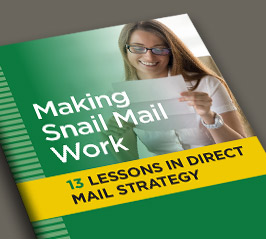
SERVICES
Direct Mail Testing
The direct marketing world has a long and well-known reputation for testing.
This reputation stems from direct marketing’s reliance of results-based marketing where every campaign is tracked, measured and analyzed.
But tracking, measuring and analyzing a campaign is NOT testing.
You can run an initial test campaign (as many do) to determine if direct mail is a viable option for your organization. The purpose of this type of test campaign is only intended to confirm or reject your assumption (although a single mailing can be very deceptive). But that’s not what testing does.
Testing is a relative matter
Testing is not about getting a good response rate or a bad response rate. It’s about getting a better response rate or worse response rate.
That’s because testing is always an exercise in comparisons – ideally an apples-to-apples comparison.
As with any scientific experiment, testing involves identifying and isolating a specific component of your campaign, then substituting that component with a new (hopefully better) component – and then running two test mailings that are exactly the same, except for the selected component.
In the end, you will have two campaign results – and one will be better than the other, which you can safely assume was due to the variable component.
Testing never stops
Testing is often viewed as a preliminary activity – something you do before you begin your direct mail campaign. Nothing could be further from the truth.
First, in order to do testing, you have to do direct mail – actually implement a campaign. No amout of market research and focus groups are going to be an adequate substitute for in-mail testing.
Second, although your early mailings are likely to run a disproportionate number of tests, your later mailings should continue to test in pursuit of even better results.
Third, always start with the big stuff first. Run tests that are going to have the largest impact on your response, and then work your way down to less significant things to test.
What we test
Audience Testing
Nothing is more important in direct marketing than reaching the right audience. But that phrase, “the right audience” should also include the phrase, “with minimal waste.”
Many mailing lists can probably reach your target audience, but the real question is which list can do so with the least amount of waste. If you are casting a wide net, you can probably reach your audience, but it’s much better to reach that same audience with a more precise list. The reason is simple: money. It costs a lot more to cast a wide net.
That’s what testing will reveal. This will be reflected in your cost-per-lead or cost-per-response analysis
Audience testing can be applied in several ways. You can test …
-
- Ideal Customer Profile
- Mailing List Types
- Mailing List Sources
- Mailing List Segments
Offer Testing
Offers are key drivers in your direct mail response. Slight tweaks in your offers can produce big swings in your response.
To a large extent, offers are intuitive. When you make your offer more generous, you will usually see an increase in response. Similarly, when make an offer more expensive (higher price) to the recipient, you can expect to see fewer responses. Finding the right combination for your organization can be achieved through testing.
But offers can also impact your response quality. For example, a subscription offer that includes a premium (free gift for signing up) will almost always increase your response, but those same subscribers may be more inclined to cancel their subscription earlier. In this case, testing would reveal that – although it might take several months to see the premature cancelation rates.
Offer testing can take many forms – depending on the type of program you’re running.
-
- Price (or donation ask)
- Price Presentation
- Bonuses/Premiums
- Hard Lead Offers
- Soft Lead Offers
- Free Trial Offers
Format Testing
Direct mail comes in many shapes and sizes. We call them formats, or mailer formats. We are all familiar with the most popular formats such as a letter mailer, postcard or folded self-mailer. There are other formats as well, but even these three come in various sizes and configurations. For example, a letter mailer will obviously include a letter, but what about a reply card or a brochure? Will those additional elements help or hurt your response?
Keep in mind that different formats come with different price tags. Postcards are almost always the cheapest option, but what if the letter mailer produces more response? These are questions that can only be answered through testing.
-
- Format Options
- Format Sizes
- Cost Variability
Message Testing
Message testing is more difficult to define, but no less important to your testing effort. When you’re creating a mailer, the first step is to come up with a main message. This is also known as the big idea or the main selling point or the big benefit or the Unique Selling Proposition (USP).
Presumably everyone will agree on this main message, but what if there are other messages that are equally important, or almost as important? This could be tested.
Beyond the main message, there are specific elements on the mailer that can also impact response. These are often creative decisions made by the writer and designer, but there are often many alternative approaches that could be more effective.
-
- Big Idea
- Envelope Teasers (or not)
- Headlines
- Charts/Graphics
- Photos
- Personalization Options
Landing Page Testing
The landing page is a key element in today’s direct mail (whether people use a QR code or type in the URL directly). But the landing page experience can vary greatly depending on the program.
Most direct mail campaigns send their prospects to an opt-in page where they complete a form – and that’s the end of it. They get a thank you page and some information is sent to the prospect via email. But what if you extended this landing page experience to include a follow-up sales page or a webinar that eventually converted that prospect into an appointment? These are things that can be tested.
-
- Landing Page Sequencing
- Opt-In Requirements
- Video Options
- Sales Page
- Order Page
Measuring the Results
In the end, the numbers will do the talking. But which numbers?
The obvious first level of measurement is going to be the response rate, but that has its limitations. For example, two mailings that have different costs but produce the same number of responses. the lower cost mailing wins that test based on a cost-per-lead.
But not all leads are created equal. For example, two mailings that produce similar response, but one mailing produces mostly appointments, while the other mailing produces a higher response, but fewer appointments. Here we would look at the “qualified” lead rate based on specific criteria for defining a qualified lead.
For direct sales (aka order generation) campaigns, you will want to look at things like the customer acquisition cost or the average order rate, or revenue or gross profit.
For recurring revenue programs, you will want to analyze how long on average a customer stays with the program and how much they will spend during that time.. This is known as the lifetime value and this becomes important when you find that your initial sales do not cover your direct mail costs. This is often the case with non-profit fundraising where the first donations are generated at a loss but with the expectation that most will give again and again.
Let's schedule a FREE Strategy Session
Do you have any questions? Would you like to know more?
Then let's schedule a one-on-one Zoom Strategy Session. There's no obligation. Just a chance to get some answers.
If you prefer, you can schedule your demo by phone at 508-473-8643,


